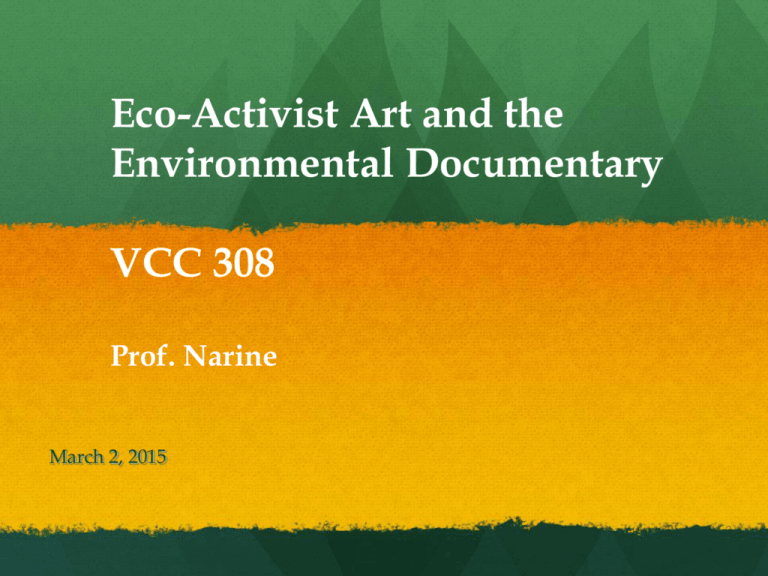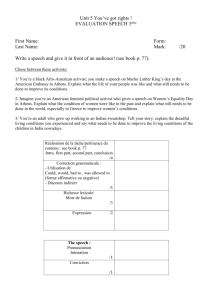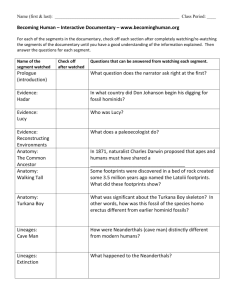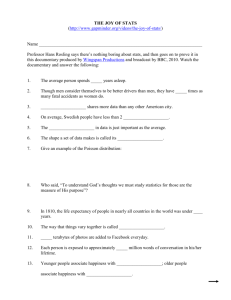vcc_308_week_9__art_eco_activism
advertisement

Eco-Activist Art and the Environmental Documentary VCC 308 Prof. Narine March 2, 2015 AGENDA How do artists envision nature? Humans and the Environment ARE WE PART OF NATURE, or SEPARATE FROM IT? How do artists relate to animals (as nature)? Why has the Eco-Documentary become an Activist form of media? How do artists envision nature? Cave Paintings of Animals (32000 BC) Egyptian Art (1500 BC) Landscape Painting Activist Performers / Celebrities Environmental Documentaries Human Domination Whether we look to the Bible, the Koran, the Tora, or Hinduism, humans are given DOMINION OVER THE EARTH, to varying degrees Humans and Nature A first step: How do we relate to Animals? Jane Goodall Did you notice the shift in tone? Goodall begins as an observer, and becomes an activist over the years. People and Animals There is new evidence that horses were domesticated in 3500 B.C.—about a thousand years earlier than previous estimates. The dog was the first domesticated animal! estimates range from roughly 13,000 to 30,000 years ago 32,000 Years Ago, France Cave of Forgotten Dreams The Cave of Forgotten Dreams (2011) Werner Herzog, director Filmmaker: Encounters at the End of the World (2009), Cave, and Grizzly Man (2005) Animals were central in human life The Cave of Forgotten Dreams The walls of the cave show people living with and eating animals But what is this relationship now? Pets Food Zoos Cowboys Farmers Humans “Training” Animals? “Breaking” horses Training pets Training whales and dolphins? (BLACKFISH) Can animals and humans work in harmony? Mahout and Elephant People Working with Animals and Nature Animals had been together with people “at the center” of our world: farming, horses and carriages In the West: Cattle, rooster in the morning! In the East: Elephants, ox for hauling and farming Case Study 1: Joseph Beuys Performance Artist “For three days in May of 1974, Joseph Beuys lived and communicated with a coyote in a small room in the newly-opened Rene Block Gallery at 409 West Broadway in New York…. It awakened the interest and curiosity of many who heard about it, far and wide.” (http://johanhedback.com/beuys.html) Joseph Beuys Joseph Beuys, activist Weapons in the war against coyotes have included: poisons such as strychnine and thallium sulfate leg hold traps, cyanide ”coyote-getters” designed to explode into the coyote's mouth snares and den-hunting to destroy pups But is the artist being ethical? Why do we kill animals (we don’t eat) like Coyotes? A Split with Nature Mass industry (1750s-1850s) brought people into cities People left farms (moreso in the Industrial West) Those on farms used more mechanized methods that detached people from animals John Berger Leading Art Historian “In the 1800s, every tradition that involved people and nature was broken” (John Berger “Why Look at Animals?”) This (tense?) relationship Becomes… Steam Engine Power People, Animals, Nature People became less familiar with animals, post 1850 Through technology, people are more detached from nature Technology mediates our relationships with nature Martin Heidegger German Philosopher A HYDRO DAM: “ ‘reveals’ the water as a reserve of electricity” LOGGING: “ ‘reveals’ the forest as a standing reserve of lumber” Martin Heidegger • Famous essay: “The Question Concerning Technology” • We see the natural world differently through technology Epistemology: we know nature differently Phenomenology: we sense nature differently What Does This Create? We share a strong desire to “return to nature” Nostalgia Peace Communion De-stressing Activism 1960s-1970s: Flower Power Activism 1990s-2000s:Nature Films Home (2009) The Cove (2009) Food Inc. (2009) Planet Earth (2001) National Geographic magazine and many documentary films (1800s-present) Case Study 2: Trash Art and Waste The Gleaners and I (Agnes Varda, 2000) (clip) Gleaning is collecting refuse Art and Waste John Knechtel Trash (link) “With every action, people make trash. Casually, as a matter of course, we throw things away. The concept of trash is the Midas touch inverted, and its malleability allows it to convert any thing or any one into garbage.” Why is this the most seen film? Why is this popular culture today? Nature vs Capitalism? Disenchantment with industrial progress Human/technological capacity to destroy the planet Impact of industrial development on natural environment Consumerism/suburbia as spiritual death DETROPIA Disasters and Civic Action 1980s: environmental disasters (Bhopal, Exxon Valdez oil spill, Chevron in Ecuador) 1990s: global ecological crisis (Kyoto Accords generated) 2000s: climate change, BP Oil Spill 2011 SO WHAT DOES THIS HISTORY MEAN FOR OUR CURRENT RELATIONSHIP WITH NATURE? Nature as Visual Pleasure Nature as Visual Pleasure Nature becomes a commodity Not just to be exploited (oil, lumber) But to be visited (tourism, zoos) …Visual Pleasure So we can consume “Nature” But we also long for a genuine return (Is there a genuine return to nature?) But we may be repressing our knowledge that… We inflict Trauma on Nature And trauma is wrought by Nature on People, which can be “natural” but can also show a relationship out of balance… Case Study 3: The Eco-Trauma Documentary ACTIVIST FILMMAKERS Documentary has a long history (1960s-present) of activism Nature documentaries were produced 1900-onward Musser: The Eco-Trauma Documentary: Grizzly Man (2005) Grizzly Man “Timothy Treadwell’s method of making contact with the creatures of Alaska’s Katmai Peninsula departs radically from the standard tropes found in excursion narratives. He is a questionable “activist.” What is he seeking? Grizzly Man In an unthinkable rupture of the boundary separating the director and his subject matter, nature refuses to stay safely on the other side of the camera. (Seegert, 2012) Treadwell is attacked by a bear Werner Herzog, director Grizzly Man Timothy’s opening monologue • How does he introduce himself? • What is his role? • Contradictions? Grizzly Man Timothy Treadwell as a self-styled “spectacle” A failed actor? A performance artist? Identity crisis? Trouble in the human world but belonging among the bears? The Cove (2009) Activists and Actors address… The yearly dolphin slaughter in Taiji, Japan CLIP The Eco-Trauma film: The Cove TV performers / celebrity activists join the fight against the dolphin hunt The Eco-Trauma Film: Last Call at the Oasis (2011) CLIP (Dir. Jessica Yu) Thesis: Suffering abounds when water runs out. Conclusion Activists take many positions against the exploitation of animals and nature generally The Cove shows how targeting a specific, discreet practice can change global opinion about eco issues in general The specific become universal (a coyote etc)







